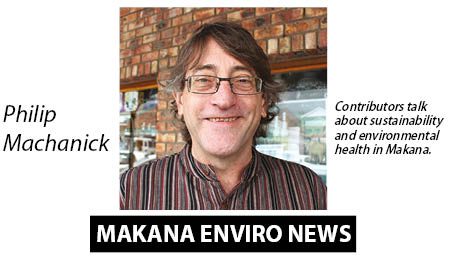Compiled by Philip Machanick
An increasing number of homes use solar hot water – even some RDP houses do – so I will not go into that but rather focus on solar-powered electricity and your options for surviving load shedding.
Solar electricity
Generating electricity directly from the sun relies on the photoelectric effect. Einstein described how this works in 1905 and was awarded the 1923 Nobel Prize in Physics for this work. The essential idea is that incoming light converts to electricity. Since sunlight varies a lot, you need some way to smooth out the resulting electricity. There are two ways to do this: use batteries or combine the produced electricity with mains power (from Eskom). Solar panels (made up photovoltaic cells) produce direct current (DC) and the voltage varies a lot so you need an inverter that converts the DC to alternating current (AC) at mains voltage.
A grid-tied system combines mains power with solar. It only works if mains is on. If you produce more than you consume, where this is allowed, the excess goes into the grid and you are paid a feed in tariff for anything your add to the grid. In Makana, grid-tied systems are not allowed. A top-up system, where your solar power adds on to mains power but cannot feed electricity to the grid, is only useful if a lot of your usage is in the day time (e.g., a shopping centre).
Battery systems fall into two categories: off-grid and hybrid. Off-grid is expensive: you need enough batteries to keep going through the longest period of no significant sunshine. In town, a hybrid system is more useful. For any battery-based system, the inverter has to also supply the correct DC voltage to the batteries and convert the battery output to mains-voltage AC.
A hybrid system has enough battery for a few hours but still relies on mains at night or when there is insufficient sunshine to operate purely on solar power. This is useful for urban homes as a backup for power outages.
The exact size of the system depends on what you want to run when power goes off. If you only want to run lights and all your lights are LEDs (the most efficient kind), a small-scale system should do. In my home, all my lights use less than 100W. Another requirement in my home is keeping the network and phones up because I use an Internet-based phone service. I also need power for my rainwater tank pump (up to 750W). Two solar panels totalling 600W, two 102Ah batteries and a 3kW inverter cover this. All lights and plugs are backed up by the system, except in areas with high power draw (kitchen, dining room and an outside plug for a lawnmower).
On a day when Eskom turned off power for almost 12 hours from 6am, I was able to plug the fridge in for brief periods, checking that there wasn’t much cloud and I didn’t drain the batteries too much. When power goes off at night, I only know because the microwave clock needs to be reset. When load is shed for 2–3 hours in the daytime, I just need to avoid using things with high power draw like a washing machine. Even when it is cloudy, the system generally at least generates enough power to keep the batteries topped up.
The installed cost is significantly higher than a generator but one of my neighbours spends about R40 per hour on diesel – so the cost in the long run is a lot lower. If you only want to keep your lights on, you should be able to get away with a much more affordable system than mine. If you can’t pay the upfront costs, look for a company that recovers the cost through your saving in electricity bills. As the cost of solar panels drops, this is a technology that is increasingly viable even for those on low incomes.
For more, see https://greenpolicyza.blogspot.com/2019/03/project-gigasolar.html
[pdf-embedder url=”https://www.grocotts.co.za/wp-content/uploads/2019/04/photovoltaic.pdf”]


